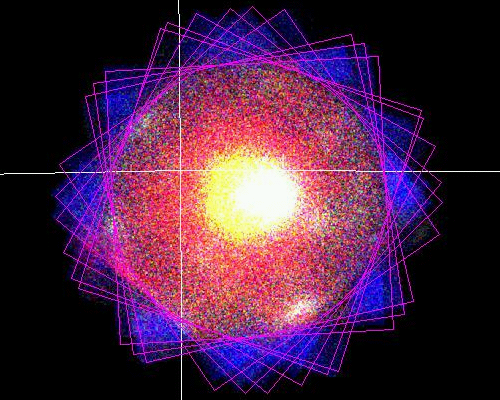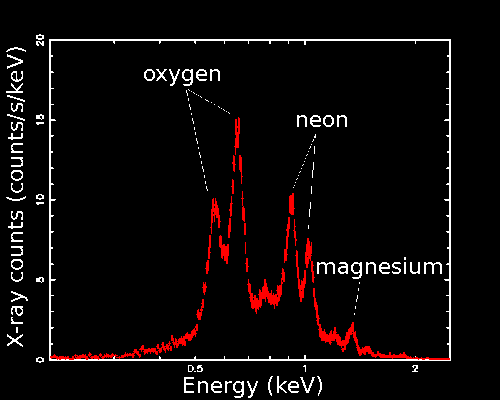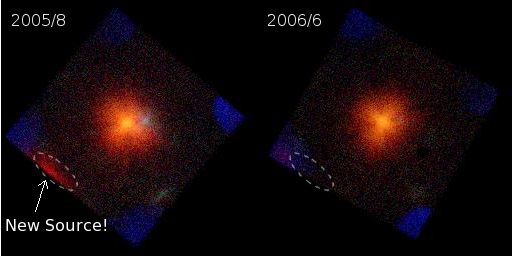► Japanese
► DARTS of the Month
A Standard Candle in the Universe - Calibrating X-ray Camera Using a Star Remnant


Left is an X-ray picture taken by Suzaku displayed with
JUDO.
When observing the universe scientifically, it is very important to accurately calibrate instruments (cameras). As a matter of fact, if you take pictures without knowing the performance of the instruments, you may not know if you are observing a new phenomena or just a "feature" of the instrument.
Upper-left is a super-position of the X-ray pictures of 1E 0102.2-7219 and fields of view of Suzaku, where nine observations are superposed. The source is a supernova remnant in the Magellanic Cloud - a galaxy next to ours. Some stars go through gigantic explosions in the end of the life, which is called supernova. "Many elements which have been created by nuclear fusion in the star are ejected at the supernova. 1E0102.2-7219 was made by such an explosion several thousand years ago, when heavy elements such as oxygen, neon, magnesium are spread in space.
The upper-right figure is an X-ray energy distribution of 1E 0102.2-7219. Sharp peaks are emission lines from oxygen, neon, magnesium and other elements. In this manner, we can tell distribution of the elements from X-ray observations.
The Suzaku team decided to use 1E 0102.2-7219 to calibrate the CCD cameras in low energy bands. Low energy X-rays are easily absorbed by the thin material layers attached on the top of the CCD cameras, so it is important to continuously monitor the performance in the low energy bands. With time, the low energy performance tends to degrade, so this source has been regularly observed about once a month (in fact, 1E 0102.2-7219 is the first source Suzaku observed). Consequently, in the left figure, many observations are superposed with different roll-angles, which are determined by the condition that the satellite solar-panel faces the Sun at the observing season. So far, 17 observations of 1E 0102.2-7219 have been carried out (you may look into by yourself using DARTS by putting "1E 0102.2-7219" in the Target Name).
We will be continuously monitoring 1E 0102.2-7219 to study instrument performance. The instrument response in lower energies thus determined is essential for reliable data analysis. For example, as long as we are certain about the instrument response, we may determine the distribution of the materials between the earth and stars by measuring the amount of X-ray absorptions due to interstellar materials.
These Suzaku "calibration data", including the ones of 1E 0102.2-7219, go public immediately after the observations. Therefore, everybody can use these data, even for scientific purposes. In fact, discovery of a new transient source using the 1E 0102.2-7219 data is recently reported (Takei et al., submitted to PASJ). By chance, one of the observations of 1E 0102.2-7219 captured a period when the source was brightened; a single stone kills two birds! The lower panel shows temperature of the X-ray sources in pseudo-colors, where 1E 0102.2-7219 is in the center and other blueish or greenish sources are also seen (the four blue sectors in the corners are calibration sources attached to the instrument). The new source which appeared in August 2005 is very red, which means the temperature is very low. Very low temperature in X-rays means it is as low as 500,000 degree or so, as opposed to typical X-ray sources which are usually 10,000,000 degree or higher. Isn't it cool?

Discovery of a transient source. The source is seen in August 2005 (lower-left edge of the field of view), but it disappeared in June 2006.
May 2007





